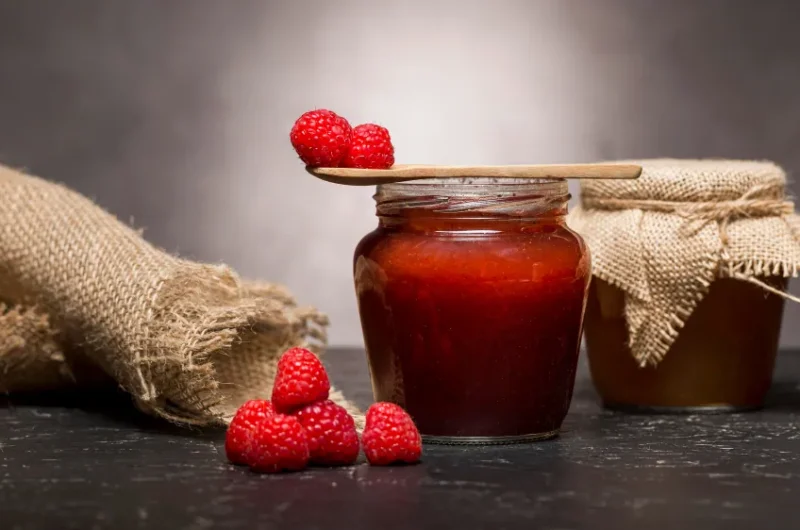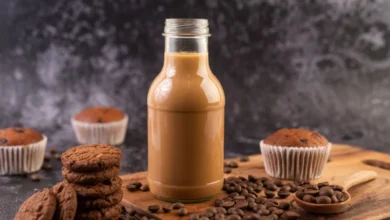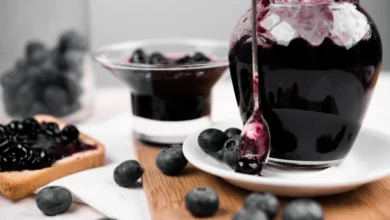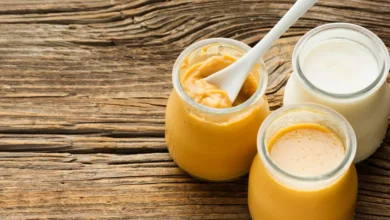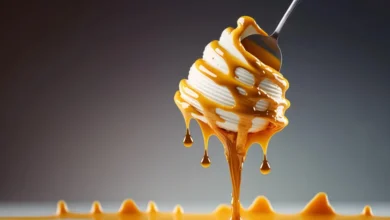Fresh Raspberry Sauce Bliss Made Simple – Give it a Whirl

Nothing brings out the gorgeous red hue and delicious flavor of fresh raspberries quite like a homemade raspberry sauce. As the weather starts to warm up, I find myself craving berries more and more. On long summer Saturdays, I love spending the afternoon in the kitchen experimenting with new recipes and learning lessons through my adventures.
A few years ago, I discovered that a sauce made from pureed fresh raspberries and a touch of sweetener is a true game-changer for everything from cakes and pastries to ice cream or yogurt parfaits. The sauce adds such a bright, tart pop of flavor that takes any dessert to the next level. I now rely on raspberry sauce for all special occasions, from backyard summer barbecues to cozy winter evenings by the fire.
With its vibrant red color and sunny flavor, it never fails to elicit smiles and requests for seconds. Most importantly, it reminds me of relaxing Saturdays spent in the kitchen creating something delicious with the seasonal bounty.
Contents
- Here’s Why You’ll Love This Recipe
- Ingredients
- Raspberry Sauce Cooking Process
- How To Use Raspberry Sauce
- Raspberry Sauce Cake Filling
- How to Store Raspberry Sauce
- Raspberry Health Benefits
- Is this the same as raspberry coulis?
- Strained vs. Keeping the Seeds
- Chef’s Notes
- Frequently Asked Questions
- What is raspberry glaze made of?
- What can I do with too many raspberries?
- How to make a raspberry coulis Mary Berry?
- Can you buy raspberry coulis?
- What is the difference between a raspberry compote and a coulis?
- What is the difference between raspberry coulis and puree?
- When should you not eat raspberries?
- Can eating too many raspberries hurt your stomach?
- Are fresh raspberries or frozen raspberries best?
- Can I reduce the sugar?
- Can I add lemon?
- Can you freeze this sauce?
- Fresh Raspberry Sauce Bliss Made Simple – Give it a Whirl
Here’s Why You’ll Love This Recipe
This sauce is so accessible and straightforward to make since it requires only a few simple ingredients found in most pantries. In just a matter of minutes, you can have a bright, fresh-tasting and tangy but not overly sweet topping that adds intense flavor punch to so many everyday dishes. Using either fresh raspberries or frozen raspberries makes this a convenient option year-round.
Best of all, no stove is needed – just blend everything together and then strain the sauce so it has a smooth but still slightly chunky texture. The versatility of this sauce is what makes it such a secret weapon in the kitchen. It can be drizzled over ice cream, swirled into yogurt or oatmeal, layered into a cheesecake pie or elevated dessert experience like lemon curd with salted caramel.
Best of all, no stove is needed – just blend everything together and then strain the sauce so it has a smooth but still slightly chunky texture. The versatility of this sauce is what makes it such a secret weapon in the kitchen. It can be drizzled over ice cream, swirled into yogurt or oatmeal, layered into a cheesecake pie or elevated dessert experience like lemon curd with salted caramel.
Many home cooks find themselves stuck in a cooking rut with the same old recipes and similar flavor profiles, leading to monotony. But with a fruity twist like this sauce, you can instantly transform both sweet and even some savory dishes. It’s an incredibly easy way to add excitement back to cooking without feeling intimidated.
Ingredients
| Ingredient | Amount | Purpose |
| Fresh raspberries | 1 1⁄2 pounds | Provide tart, fruity flavor and color. |
| White sugar | 1⁄4 cup | Balances the tartness of the raspberries with a touch of sweetness. |
| Water | 1 tablespoon | Helps raspberries release their juices during blending. |
| Lemon juice | 2 teaspoons | Adds brightness and cuts through richness; prevents browning. |
| Cornstarch | 1 teaspoon | Thickens the sauce into a coating consistency without making it lumpy or powdery. |
Raspberry Sauce Cooking Process
To make the fresh raspberry sauce, start by combining the fresh raspberries, white sugar, and water in a saucepan. Bring the mixture to a gentle boil over medium-low heat and let it boil for 2–3 minutes, stirring occasionally, until the raspberries have softened. Remove from heat and use an immersion blender or regular blender to purée the raspberries until smooth.
Strain the pureed raspberries through a fine mesh strainer to remove seeds. Then, in a small cup, mix 1 teaspoon white cornstarch with 1 teaspoon water to form a slurry. Whisk the slurry into the hot raspberry mixture. Return the pan to low heat and cook, whisking constantly, until the sauce has thickened slightly, 1–2 minutes more.
Remove from heat and stir in the lemon juice. Let the sauce cool completely before transferring to an airtight container. The sauce will thicken more as it cools. Store in the refrigerator for up to 5 days. Stir gently before serving to combine any separated mixture. It’s also delicious stirred into yogurt, ice cream or drizzled over butter on hot dishes for a delicious richness.
RELATED: Fresh Strawberry Sauce
How To Use Raspberry Sauce
This versatile fresh raspberry dessert sauce can be enjoyed in so many creative ways. A few spoonfuls are delicious swirled into yogurt or cottage cheese for a bright pop of flavor. You can also stir a few tablespoons into oatmeal for a fruity breakfast twist.
Beyond simply enjoying raspberry sauce straight up with a spoon, it can be wonderfully versatile in both sweet and savory preparations. Homemade raspberry sauce is delicious drizzled over pancakes, waffles, or French toast for a burst of bright berry flavor.
It also works well sandwiched between layers of vanilla or red velvet cake for a pop of color and premium taste. The sauce balances the richness of the cake perfectly. A drizzle over slices of pound cake or scones likewise elevates these treats.
For baked goods, it’s divine drizzled over scones, crepes, muffins, or buttermilk waffles. The sauce also makes an elegant topping for cream cheese pound cake or a filling for lemon cupcakes and lemon blueberry cupcakes. Beyond breakfast and baking, get creative, pairing the sauce with chocolate treats like brownies and chocolate cake.
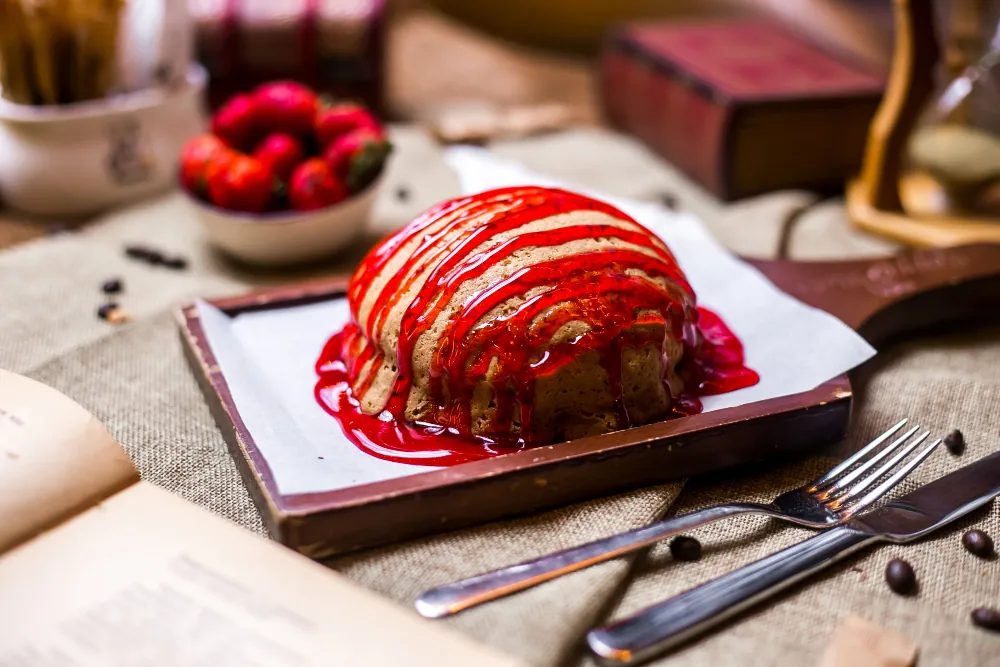

It’s also heavenly paired with choux pastry or cream puffs for an indulgent finish. For an effortless garnish, spoonfuls of the sauce are beautifully swirled into whipped cream or whipped frosting. Lastly, a few drizzles transform any dessert – from cheesecake to angel food cake – into a fruity and special treat.
Raspberry Sauce Cake Filling
While the fresh raspberry sauce has a lovely flavor that would complement cakes, the texture may be too thin to use directly as a filling. When baked into cakes, the sauce could potentially soak into the cake rather than remaining as a distinct layer between layers or in cupcakes.
A few options to consider instead:
- Thicken the sauce slightly with an additional tablespoon of cornstarch to create a spreadable consistency better suited to filling cakes.
- Fold the raspberry sauce gently into whipped cream or sweetened mascarpone/cream cheese to lighten its texture before using as a filling.
- Drizzle or brush the raspberry sauce thinly over baked cake layers before frosting instead of using it directly as a filling layer.
So in conclusion, while the fruity flavor of this fresh raspberry sauce would pair beautifully with cakes, its thin nature means it may not hold its shape well when used directly as a filling. Adjusting the texture slightly could make it work well or sticking to topping applications is another good option.
How to Store Raspberry Sauce
Fresh raspberry sauce is best stored in an airtight container in the refrigerator for optimal freshness and flavor. The cold temperature of the fridge will help prevent the growth of any microorganisms and slow down detrimental chemical changes that can reduce quality over time. For maximum freshness, enjoy raspberry sauce within 3–5 days of preparation.
We can also freeze in freezer safe containers or ziplock bags for longer term storage of up to 3 months. When ready to use frozen raspberry sauce, simply thaw it in the refrigerator overnight before serving. Proper refrigeration or freezing will help preserve the bright color and delicious fruity flavor of the homemade raspberry sauce.
Raspberry Health Benefits
Raspberries are highly packed with many potential health benefits due to their high nutrient content. Raspberries are packed with vitamin C, which can help manage blood sugar levels and reduce insulin resistance. This supports those with diabetes.
The antioxidants and fiber in raspberries deliver antioxidant plant compounds that may support cognitive function and brain health. Raspberries are also full of manganese, a mineral important for bone health, metabolism, and nerve function.
They are high in fiber, which promotes healthy digestion and feelings of fullness. The soluble fiber may help manage blood sugar levels. Regularly eating raspberries as part of an overall healthy diet provides important vitamins, minerals and phytonutrients that can reduce inflammation and support overall health and well-being.
So in summary, delicious raspberries offer a variety of potential health benefits through their nutritional properties.
Is this the same as raspberry coulis?
While fresh raspberry sauce and raspberry coulis both showcase the bright flavor of fresh raspberries, they differ in their preparations and intended uses. The following table highlights some of the key distinctions between a general raspberry sauce versus a traditional raspberry coulis, with a focus on ingredients, textures, flavors and common applications.
| Raspberry Sauce | Raspberry Coulis |
| A broad term used for various fruit preparations that can be chunky or smooth | A more specific type of sauce – the word coulis comes from the French verb coulis, meaning “to flow” |
| Can vary in sweetness levels and include added ingredients like spices, vinegar, other fruits, orange juice etc. | Traditionally made only from pureed fruit or vegetables with a touch of sugar and lemon juice |
| Intended as a general topping or accompaniment for desserts and sometimes savory dishes | The primary goal is to enhance and bring out the natural flavor of the main ingredient |
| Texture can vary from thick to thin depending on recipe | Strained to remove seeds and other solids for a silky, velvety consistency |
| Flavors are balanced, but taste is less focused on the main fruit | Tastes predominantly of the main fruit with less common use of additional flavorings |
Strained vs. Keeping the Seeds
Here are some things to consider when deciding whether to strain or keep the seeds when making raspberry sauce:
Whether straining or skipping the straining step, there are pros to both textures. Straining will result in a thinner, smoother sauce that’s great for purposes like drizzling.
Skipping the strain yields a slightly thicker, chunkier sauce since the seeds are left in. Some people prefer this texture, especially if using the sauce as a topping where the seeds provide extra bits of fruit.
As an example, the recipe [Raspberry Sauce] yields about 1/2 cups if straining all the seeds out. If you skip straining, the final yield will likely be closer to 3/4-1 cups depending on your berries’ juiciness.
Consider your intended use and personal taste – straining allows a smooth texture that won’t distract from other flavors being drizzled on. Leaving the seeds provides texture and visual appeal some enjoy when eating the sauce plain. Experiment to see which version you and your family prefer. At the end of the day, both smooth and seedy styles are delicious ways to enjoy raspberries!
Nutrition Facts
| Amount | Per Serving |
| Calories | 44 |
| Fat | 0g |
| Carbs | 11g |
| Protein | 1g |
This fresh raspberry sauce is low in calories yet delivers antioxidants and vitamins. While carbs are moderate at 11g per serving, the natural sugar comes from the fresh fruit. Best of all, there is no added fat or cholesterol. Overall, this makes for a nutritious yet indulgent way to enjoy the bright flavor of raspberries. Feel free to adjust servings based on your own nutrition needs and goals.
Chef’s Notes
This fresh raspberry sauce makes for a healthy, low-calorie, low-fat food option. While the nutrition facts provided are generic for the recipe, the actual nutritional content can vary depending on the exact ingredients and how you prepare it. Some tips to make it especially healthy include using fresh or frozen raspberries rather than canned or jarred varieties, which may contain added sugar or preservatives.
For sweetener, consider options like honey or maple syrup instead of refined sugar. A small amount of a thickener like cornstarch or arrowroot powder can help with consistency without extra calories. Most important is enjoying it in moderation and controlling portion sizes. Overall, this raspberry sauce makes a nutritious yet delicious way to enjoy the bright flavor of the berries while getting vitamins, fiber and other nutrients. Serve it up and enjoy!
For those nights when you want a homemade sauce but don’t have much time, a no-cook raspberry sauce saves the day. Simply puree 1 pint fresh or frozen raspberries with 1/4 cup honey or maple syrup in a blender until smooth. No cooking or heating required – this technique lets the peak berry flavor shine through. Blend, then either serve or store in the fridge for up to 5 days. It’s the perfect guilt-free sweet treat with no baking or stove-top time needed.A no-cook method really lets the bright flavor of seasonal raspberries take center stage.
My Final Thoughts
Homemade fresh raspberry sauce is a tasty way to enjoy the flavors of summer well after the berry season is over. With just a few simple ingredients, anyone can make a batch of this bright purple condiment. Straining or leaving the seeds adds different textures to suit various applications. Proper storage in the refrigerator or freezer extends the shelf life for weekly enjoyment. Most importantly, raspberry sauce delivers nutrient-packed berries in a delicious vehicle. Whether as a topping, dip, or simple snack, this versatile sauce brings the joy of fresh raspberries to any time of year.
Frequently Asked Questions
What is raspberry glaze made of?
Raspberry glaze is similar to fresh raspberry sauce but with a thicker, syrup-like consistency. It’s typically made by simmering raspberries with sugar or other sweetener until the fruit breaks down and thickens into a smooth, jam-like glaze.
What can I do with too many raspberries?
If you find yourself with more raspberries than you can eat fresh raspberry sauce, you can easily make jam, compote or freeze them for later. Raspberries also blend well into smoothies, yogurt or oatmeal.
How to make a raspberry coulis Mary Berry?
Mary Berry’s classic raspberry coulis recipe simply calls for blending fresh raspberries with a bit of sugar until smooth. Straining removes the seeds for a silky smooth texture.
Can you buy raspberry coulis?
Yes, you can find prepared raspberry coulis for purchase at most grocery stores. It’s convenient but homemade will be fresher and you can control the ingredients.
What is the difference between a raspberry compote and a coulis?
A compote has a chunkier texture from leaving in some raspberry seeds and skins. A coulis blends to a smooth puree, usually strained to remove all seeds and skins.
What is the difference between raspberry coulis and puree?
A puree is thicker than a coulis and may contain more seeds and skins. Coulis refers to a smoother consistency achieved through more blending or straining of the seeds and skins.
When should you not eat raspberries?
Raspberries are generally safe but some people may experience an allergic reaction like hives. It’s best to introduce them slowly the first time. Don’t eat moldy or spoiled raspberries.
Can eating too many raspberries hurt your stomach?
In moderation, raspberries are unlikely to cause stomach upset for most people. As with any fruit, eating a large amount may lead to diarrhea or cramps in sensitive individuals.
Are fresh raspberries or frozen raspberries best?
Both have value – fresh may have optimum flavor but frozen also locks in nutrients. Frozen are a convenient option year-round too for sauces and baking.
Can I reduce the sugar?
Yes, feel free to adjust the sweetness to your liking by reducing or replacing some of the sugar called for in recipes. Start with half and taste as you go.
Can I add lemon?
A squeeze of lemon juice can brighten the flavor profile. Add it to taste right before serving or storing. Too much may cause discoloration over time.
Can you freeze this sauce?
Yes, raspberry sauce freezes well for several months. Leave headspace in containers since liquids expand as they freeze. Thaw in the fridge before serving.
Fresh Raspberry Sauce Bliss Made Simple – Give it a Whirl
Course: Dessert SaucesCuisine: American5
servings10
minutes30
minutes44
kcal40
minutesMake the most of summer’s sweet raspberries with this fresh fruit sauce. Drizzle it over yogurt or ice cream for an instant sunny taste of season.
Ingredients
Fresh raspberries – 1 1⁄2 pounds
White sugar – 1⁄4 cup
Lemon juice – 2 teaspoons
Cornstarch – 1 teaspoon
Water – 1 tablespoon
Directions
- Combine raspberries, sugar, and water in a saucepan. Bring to a boil and simmer 2-3 minutes.
- Purée mixture and strain out seeds.
- Make cornstarch slurry and whisk into purée. Cook until slightly thickened.
- Stir in lemon juice. Cool completely before serving or storing in fridge up to 5 days.

